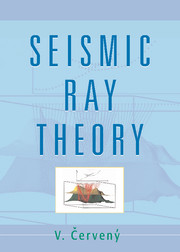Book contents
- Frontmatter
- Contents
- Preface
- 1 INTRODUCTION
- 2 THE ELASTODYNAMIC EQUATION AND ITS SIMPLE SOLUTIONS
- 3 SEISMIC RAYS AND TRAVEL TIMES
- 4 DYNAMIC RAY TRACING. PARAXIAL RAY METHODS
- 5 RAY AMPLITUDES
- 6 RAY SYNTHETIC SEISMOGRAMS
- APPENDIX A FOURIER TRANSFORM, HILBERT TRANSFORM, AND ANALYTICAL SIGNALS
- References
- Index
6 - RAY SYNTHETIC SEISMOGRAMS
Published online by Cambridge University Press: 03 February 2010
- Frontmatter
- Contents
- Preface
- 1 INTRODUCTION
- 2 THE ELASTODYNAMIC EQUATION AND ITS SIMPLE SOLUTIONS
- 3 SEISMIC RAYS AND TRAVEL TIMES
- 4 DYNAMIC RAY TRACING. PARAXIAL RAY METHODS
- 5 RAY AMPLITUDES
- 6 RAY SYNTHETIC SEISMOGRAMS
- APPENDIX A FOURIER TRANSFORM, HILBERT TRANSFORM, AND ANALYTICAL SIGNALS
- References
- Index
Summary
Under ray synthetic seismograms, we understand time-domain, high-frequency asymptotic solutions of the elastodynamic equation by the ray method. Ray synthetic seismograms are represented by a superposition of elementary ray synthetic seismograms, corresponding to the individual elementary body waves arriving at the receiver within a specified time window. In a layered 3-D structure, there may be many seismic body waves that travel from the source to the receiver along different ray trajectories. They correspond to various reflected, refracted, multiply-reflected, converted, and other seismic body phases.
In this chapter, we shall consider only standard, zeroth-order elementary waves in the construction of ray synthetic seismograms. Waves of higher order (such as head waves), diffracted, inhomogeneous, and other waves that cannot be described by standard ray approaches will not be included in the superposition. Moreover, we shall not consider the higher order terms in the ray series for individual elementary waves; all elementary waves will be represented only by their zeroth-order ray approximation. Thus, it would be more precise to speak of zeroth-order ray synthetic seismograms. We shall, however, avoid the term zeroth-order to make the terminology simpler. We believe this will not cause any misunderstanding. Of course, the ray synthetic seismograms studied here may also be extended to include certain types of waves not included among zeroth-order ray approximation waves. This would, however, require special treatment. See a brief exposition in Section 6.2.5.
If the individual waves forming the ray synthetic seismograms are separated and do not interfere mutually in certain regions, it is possible to study them separately. For example, their amplitudes may be fully determined by the equations of Sections 5.1, 5.2, and 5.4.
- Type
- Chapter
- Information
- Seismic Ray Theory , pp. 621 - 660Publisher: Cambridge University PressPrint publication year: 2001



